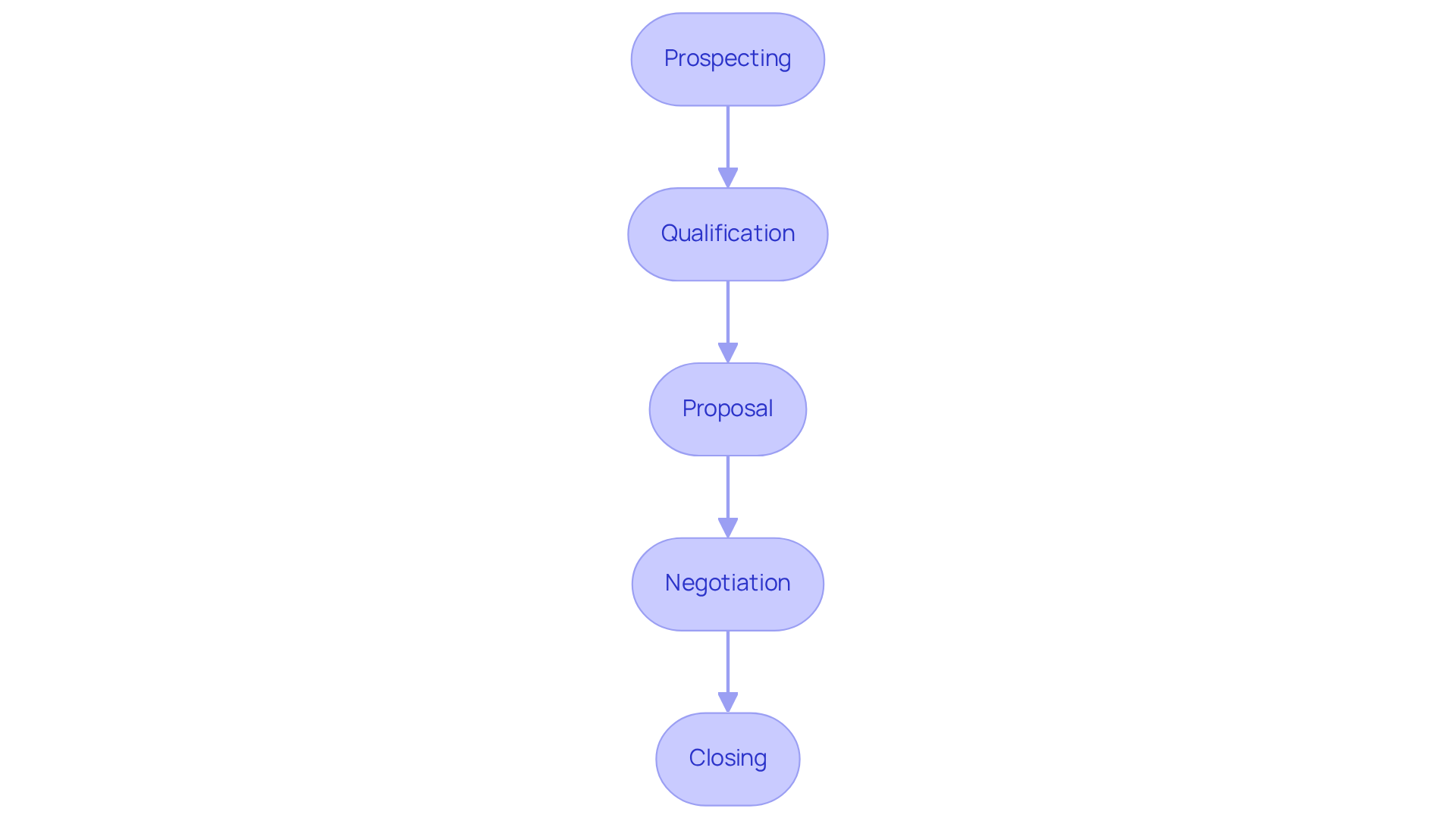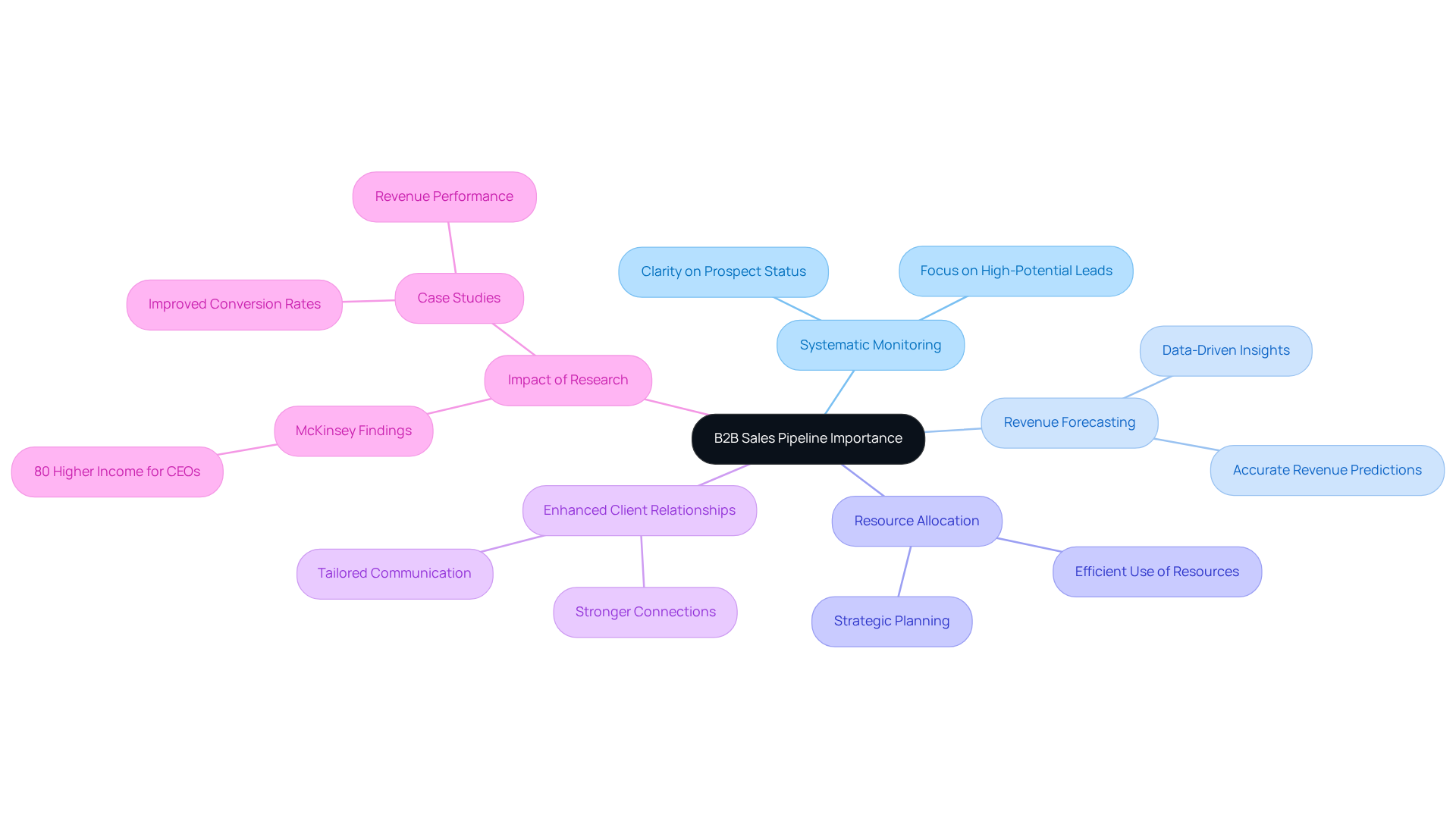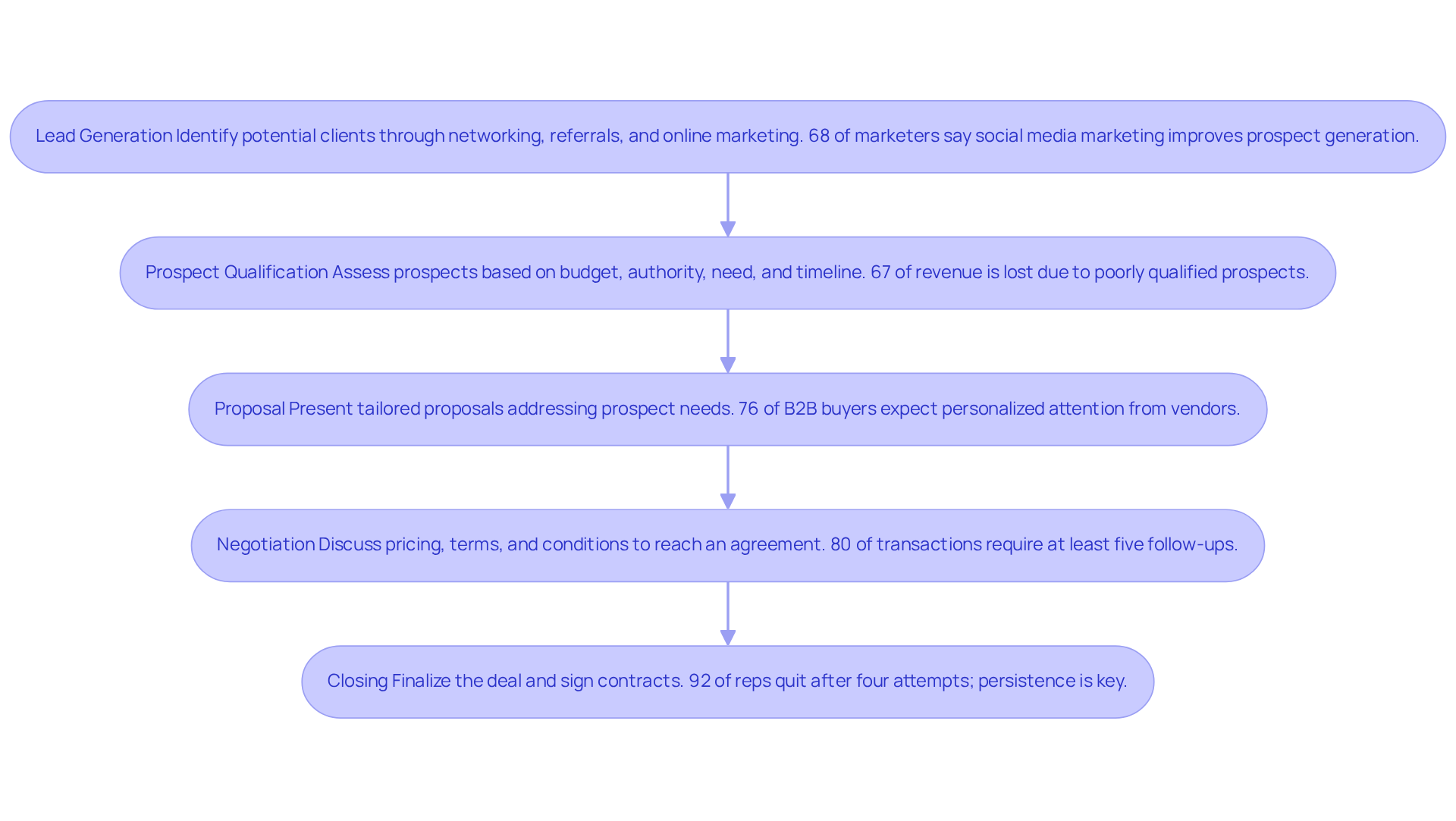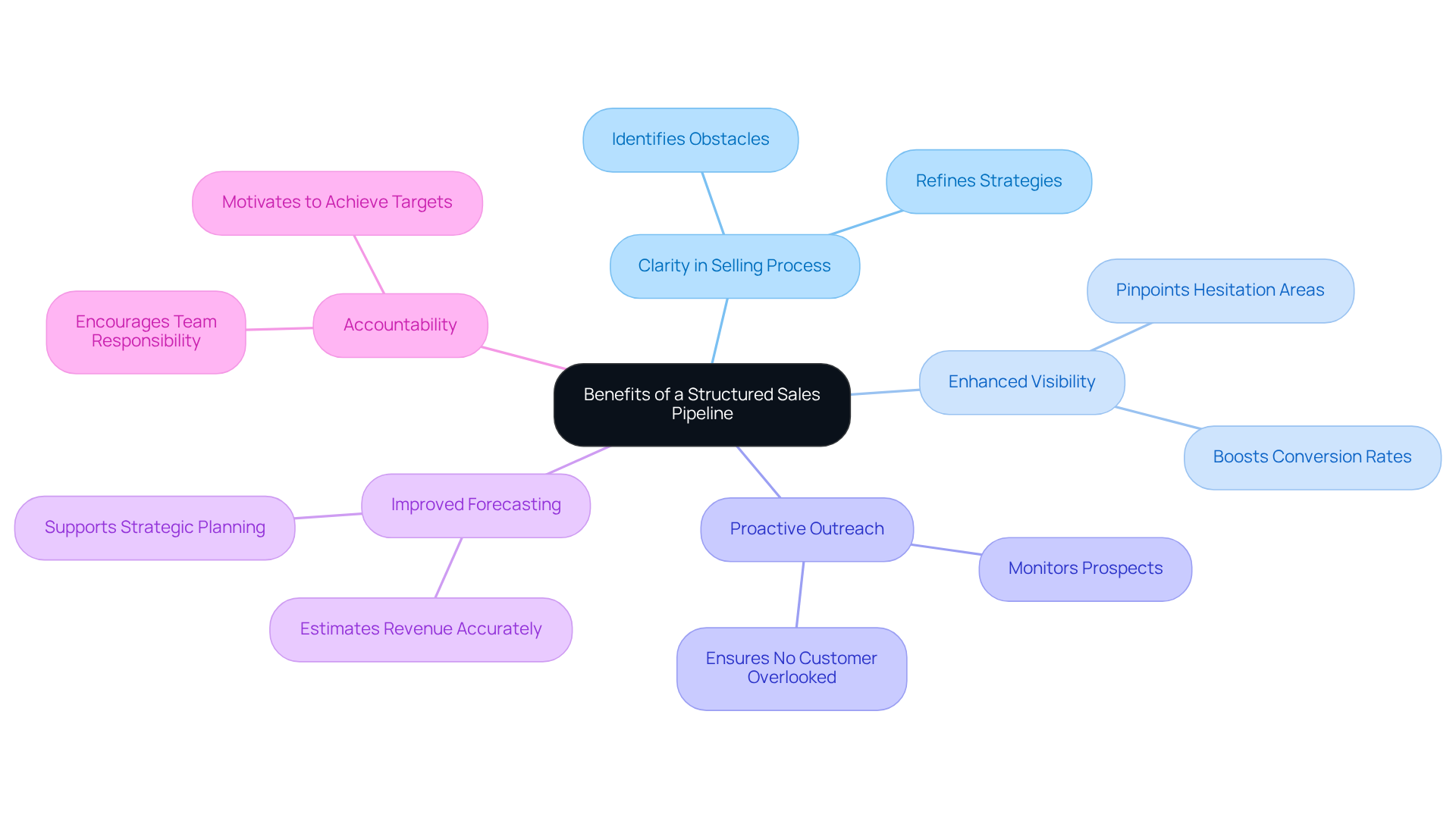Overview
The B2B sales pipeline is crucial for the success of small businesses, providing a structured framework that guides prospective clients from awareness to acquisition. By doing so, it helps maximize conversion rates, which we know is a top priority for you. Understanding and implementing the key stages—prospecting, qualification, proposal, negotiation, and closing—allows small businesses to manage sales processes effectively. This understanding not only aids in forecasting revenue but also enhances client relationships, ultimately driving sustainable growth.
We understand your challenges in navigating the sales landscape. By focusing on these stages, you can create a more organized approach that leads to better outcomes. Imagine the difference it could make in your business when you can predict your revenue more accurately and foster stronger connections with your clients. Together, we can achieve success by embracing these strategies and making them work for you.
Introduction
Understanding the B2B sales pipeline is essential for small businesses striving to thrive in today’s competitive landscape. We recognize the challenges you face, and this structured framework not only clarifies the journey from lead generation to closing deals but also enhances operational efficiency and revenue forecasting.
Many small enterprises struggle with effectively managing their sales processes, often losing valuable prospects along the way. What strategies can we implement together to optimize each stage of the pipeline and ensure that no opportunity slips through the cracks? Your success is our priority, and we are here to support you in navigating this journey.
Define the B2B Sales Pipeline
The B2B sales pipeline serves as a vital framework for small enterprises, showcasing the path prospective clients follow from their initial awareness to final acquisition. This visual representation encompasses all vital stages of the B2B sales pipeline involved in transforming prospects into clients, including:
- Prospecting
- Qualification
- Proposal
- Negotiation
- Closing
Each phase is thoughtfully designed to track lead progress and pinpoint where potential clients may lose interest, empowering companies to refine their strategies effectively.
For small business owners, grasping the intricacies of the B2B sales pipeline is crucial, as it offers a structured method for managing sales initiatives and boosting conversion rates. Have you considered how targeted outreach tactics, like utilizing the F&B Professionals Email List or the Michigan B2B Email List, can enhance your sales pipeline efforts? By engaging with the right prospects at the right time, you can make a significant impact.
Additionally, with Wayy.ai, small enterprise owners can receive daily email insights that monitor key metrics, such as:
- The number of prospects reached
- Those who expressed interest
- The conversion rate
This enables you to see exactly what’s working each day. This organized approach not only helps in identifying bottlenecks but also fosters growth by maximizing the potential of each opportunity. Together, we can navigate these challenges and achieve success in your sales endeavors.

Contextualize the Importance of a B2B Sales Pipeline
Understanding the importance of a B2B sales pipeline is essential for small enterprises, especially those operating with limited resources. A well-organized B2B sales pipeline not only facilitates systematic monitoring of prospects but also aids in precise revenue forecasting and efficient resource allocation. It clarifies the status of each prospect within the business process, allowing teams to focus on high-potential leads. In today’s competitive landscape, having a clear process empowers small businesses to stand out by connecting with potential clients at opportune moments through tailored communication.
This strategic approach not only enhances operational efficiency but also fosters stronger relationships with potential clients. For instance, research from McKinsey reveals that CEOs who prioritize revenue management can achieve up to 80% higher income and profitability compared to their peers. Moreover, case studies illustrate that companies employing a structured B2B sales pipeline have seen significant improvements in conversion rates and overall revenue performance. Consider the SaaS firm that needs to generate 3,000 sales-qualified opportunities to reach a $6 million revenue goal.
By continually refining their strategies based on data insights, small enterprises can elevate their growth trajectory and secure long-term success. Together, we can navigate these challenges and achieve remarkable outcomes. Remember, every step taken towards improving your sales framework is a step towards a brighter future for your business.

Outline the Key Stages of a B2B Sales Pipeline
The B2B sales pipeline consists of several essential stages that guide potential clients from initial contact to finalizing a deal:
-
Lead Generation: This foundational stage is all about identifying potential clients through various channels, such as networking, referrals, and online marketing. We understand that effective prospect generation strategies are crucial; in fact, 68% of marketers indicate that social media marketing has greatly improved their prospect generation efforts. It’s also important to note that 41% of firms find it challenging to promptly follow up with prospects, underscoring the significance of timely interaction in this phase.
-
Prospect Qualification: At this stage, we assess prospects based on specific criteria such as budget, authority, need, and timeline. A robust prospect qualification process is essential in the B2B sales pipeline; statistics reveal that firms forfeit 67% of revenue due to inadequately qualified prospects. Additionally, only 27% of prospects forwarded to sales by marketers are qualified, highlighting the disparity in qualification processes. Implementing frameworks like BANT can streamline this process, ensuring that only high-potential prospects are pursued.
-
Proposal: Once leads are qualified, a tailored proposal is presented, detailing how we can address the prospect's needs. This personalized approach is vital, as 76% of B2B buyers expect personalized attention from vendors, which can significantly influence their purchasing decisions. Organizations that coordinate their marketing and customer engagement teams experience 36% greater customer retention and 38% higher success rates, emphasizing the importance of personalization and alignment in proposals.
-
Negotiation: This stage involves discussions regarding pricing, terms, and conditions, where both parties aim to reach a mutually beneficial agreement. Effective negotiation strategies can enhance the likelihood of closing deals, especially when both sides feel their needs are being met. It’s noteworthy that 80% of transactions necessitate a minimum of five follow-ups, highlighting the perseverance required during negotiations.
-
Closing: The final stage of the pipeline is where the deal is finalized, and contracts are signed. Successful closing often necessitates persistence, as 80% of transactions require at least five follow-ups, emphasizing the significance of sustaining engagement throughout the process. Moreover, 92% of representatives resign after four tries, reinforcing the necessity for ongoing involvement to finalize agreements.
Each of these stages plays an essential role in nurturing leads effectively within the B2B sales pipeline, ultimately leading to successful conversions and growth. Together, we can navigate these stages with understanding and support, ensuring a positive experience for both you and your prospects.

Highlight the Benefits of a Structured Sales Pipeline
Establishing a structured b2b sales pipeline can provide significant advantages for small enterprises. It brings clarity to the selling process, helping your team identify obstacles and refine strategies more effectively. Have you ever felt stuck in your sales efforts? Enhanced visibility allows sales groups to pinpoint areas where prospects might hesitate, enabling prompt actions that can boost conversion rates. Moreover, a systematic approach ensures that no potential customer is overlooked; each prospect is carefully monitored through various phases, promoting a proactive outreach strategy. This diligent tracking is crucial, as research indicates that 40% of companies fail to meet revenue targets due to poorly managed revenue streams.
Additionally, a clearly defined sales process enhances forecasting, allowing you to estimate revenue more accurately based on the number of prospects at each stage. This predictive ability is essential for strategic planning and resource allocation. It also encourages accountability among team members, as everyone can see their contributions to overall revenue goals. By nurturing a culture of transparency and responsibility, your team will feel more motivated to achieve their targets.
Ultimately, a structured sales pipeline not only streamlines your sales process but also drives sustainable growth for small businesses like yours. It empowers you to navigate the complexities of client acquisition with confidence and efficiency. Together, we can embrace these strategies to ensure your business thrives.

Conclusion
Understanding the B2B sales pipeline is essential for small businesses striving for success in a competitive market. This structured framework not only guides potential clients from initial awareness to final acquisition, but also equips business owners with the necessary tools to manage and optimize their sales processes effectively. By recognizing the significance of each stage—from prospecting to closing—small enterprises can enhance their conversion rates and foster long-term growth.
In this article, we delve into the key stages of the B2B sales pipeline, highlighting the importance of:
- Lead generation
- Qualification
- Proposal presentation
- Negotiation
- Closing
Each phase plays a critical role in nurturing leads and ensuring that businesses can identify and address potential obstacles. A well-organized sales pipeline enables better revenue forecasting, resource allocation, and relationship building, ultimately leading to improved sales performance.
As small businesses navigate the complexities of the B2B landscape, leveraging a structured sales pipeline becomes a crucial strategy for achieving sustainable growth. By implementing these practices, you can not only improve your sales efforts but also create a more accountable and motivated team. Embracing the principles outlined in this article can pave the way for a brighter future, where every interaction with prospects is maximized for success. Together, we can achieve the growth you envision.
Frequently Asked Questions
What is the B2B sales pipeline?
The B2B sales pipeline is a framework that illustrates the journey prospective clients take from initial awareness to final acquisition, encompassing stages such as prospecting, qualification, proposal, negotiation, and closing.
Why is the B2B sales pipeline important for small enterprises?
It provides a structured method for managing sales initiatives and improving conversion rates, helping small business owners track lead progress and identify where potential clients may lose interest.
What are the key stages of the B2B sales pipeline?
The key stages of the B2B sales pipeline include prospecting, qualification, proposal, negotiation, and closing.
How can targeted outreach tactics enhance the B2B sales pipeline?
Targeted outreach tactics, such as using specific email lists, can help engage the right prospects at the right time, significantly impacting sales pipeline efforts.
What metrics can small business owners monitor with Wayy.ai?
Small business owners can monitor metrics such as the number of prospects reached, those who expressed interest, and the conversion rate.
How does monitoring key metrics benefit small enterprises?
Monitoring key metrics helps identify bottlenecks in the sales process and fosters growth by maximizing the potential of each opportunity.




